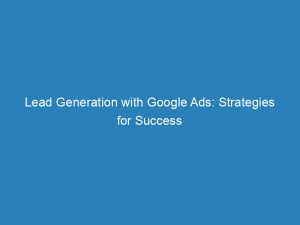- lead generation google ads
- First-Party Data For Strong Measurement Foundation
- Generating 2X Incremental Revenue With First-Party Data
- Collecting Online First-Party Data With First-Party Cookies
- Enhanced Web Conversions For Improved Measurement Accuracy
- Connecting Offline First-Party Data With Google Ads
- Upgrading To Non-Last Click Attribution For Better Credit Allocation
- Data-Driven Attribution For More Conversions At A Similar Cost
- Indicating Valuable Customer Actions For Identifying High-Quality Leads
In the fast-paced world of digital advertising, successful lead generation is the holy grail, fueling the growth and success of businesses across industries. And when it comes to capturing those elusive leads, there is no denying the power of GoogleAds.
With its vast reach and precision targeting capabilities, GoogleAds has become the go-to platform for businesses large and small. However, with increased competition and evolving consumer behavior, it is imperative to stay ahead of the curve to maximize your ad campaign’s effectiveness.
In this article, we will unveil the secret sauce for lead generation success on GoogleAds, leveraging first-party data and enhanced conversions. Get ready to unlock a world of accurate measurements, high-quality leads, consolidated customer data, increased revenue, and optimized ad campaigns like never before.
| Item | Details |
|---|---|
| Topic | Lead Generation with Google Ads: Strategies for Success |
| Category | Marketing |
| Key takeaway | In the fast-paced world of digital advertising, successful lead generation is the holy grail, fueling the growth and success of businesses across industries. |
| Last updated | December 28, 2025 |
ads">lead generation google ads
Google Ads is a powerful tool for lead generation, but users’ concerns over data usage and privacy regulations can make digital measurement challenging. However, by employing first-party data and effective measurement strategies, businesses can generate significant revenue.
First-party data, collected using first-party cookies, forms the foundation for accurate measurement. Enhancing conversions for web and connecting offline first-party data with Google Ads allows for targeted advertising.
Upgrading to non-last click attribution and utilizing data-driven attribution further improve measurement accuracy and deliver more conversions. Indicating valuable customer actions helps identify high-quality leads, while consolidating platforms centralizes customer data.
Keyword-targeted campaigns on the Google Search Network and contextual targeting on the Google Display Network can attract potential leads. Utilizing rich-media ad formats, cost-per-click bidding, and the Conversion Tracking tool allows for effective measurement of campaign effectiveness.
Offering distinct offers, providing sufficient information, including multiple response options and a clear call to action, and utilizing the Display Planner for generating ideas further enhance lead generation with Google Ads.
This post updated with new ad network performance data.
Key Points:
- First-party data and accurate measurement are crucial for lead generation on Google Ads.
- Utilizing non-last click attribution and data-driven attribution improves measurement accuracy and generates more conversions.
- Keyword-targeted campaigns on the Google Search Network and contextual targeting on the Google Display Network attract potential leads.
- Utilizing rich-media ad formats, cost-per-click bidding, and the Conversion Tracking tool allows for effective campaign measurement.
- Offering distinct offers, providing sufficient information, and including multiple response options and a clear call to action enhance lead generation.
- Utilizing the Display Planner for generating ideas further enhances lead generation with Google Ads.
Sources
https://support.google.com/google-ads/answer/1722135?hl=en
https://ads.google.com/intl/en_us/growthformula/generate-leads/
https://www.thinkwithgoogle.com/consumer-insights/consumer-journey/advertising-lead-generation-guide/
https://ads.google.com/local-services-ads/
Check this out:
💡 Pro Tips:
1. Utilize Google Ads for lead generation and sales, as it offers a wide range of targeting options and ad formats to reach your target audience effectively.
2. Take advantage of keyword-targeted campaigns on the Google Search Network to ensure your ads appear when users search for relevant keywords related to your products or services.
3. Use the Google Display Network for contextual targeting, allowing you to display your ads on websites that are contextually relevant to your business and reach a larger audience.
4. Take advantage of placement targeting on the Google Display Network to select specific websites or sections where you want your ads to appear, ensuring your message reaches the right audience.
5. Consider using rich-media ad formats and cost-per-click bidding to make your ads more visually engaging and increase the chances of attracting clicks and generating leads.
First-Party Data For Strong Measurement Foundation
In the digital marketing landscape, where users’ concerns over data usage and privacy regulations create challenges for accurate measurement, the effective use of first-party data has become crucial. First-party data refers to the information collected directly from users or customers.
It includes data collected from interactions on websites, mobile apps, and offline channels. By leveraging first-party data, advertisers can establish a strong foundation for measurement and improve their lead generation efforts.
One of the primary reasons first-party data is important for measurement is that it provides accurate and reliable information about user behavior and preferences. Unlike third-party data, which may not be as trustworthy or comprehensive, first-party data offers insights into actual customer interactions.
This data can help advertisers understand their target audience better, optimize their campaigns, and tailor their messaging to maximize impact.
Key takeaway: Utilizing first-party data is crucial for establishing a strong measurement foundation for lead generation efforts on Google Ads.
Generating 2X Incremental Revenue With First-Party Data
Beyond providing a solid measurement foundation, effective use of first-party data can also generate significant incremental revenue. Studies have shown that by leveraging first-party data, advertisers can achieve up to 2 times more revenue compared to relying solely on third-party data or generic targeting tactics.
The reason behind this revenue boost is the increased precision and relevance that first-party data enables. By tapping into their own customer data, advertisers can segment their audience based on specific attributes, behaviors, or preferences.
This segmentation allows for more personalized messaging and targeting, resulting in higher conversion rates and increased revenue.
Key takeaway: Leveraging first-party data can significantly increase revenue by enabling precise targeting and personalized messaging.
Collecting Online First-Party Data With First-Party Cookies
An essential tool for collecting online first-party data is the use of first-party cookies. These cookies, implemented on advertisers’ websites, allow them to track and collect user information directly.
First-party cookies are considered more reliable and privacy-friendly compared to third-party cookies, which are often blocked by browser settings or ad-blocking software.
By using first-party cookies, advertisers can gather valuable information on user behavior, such as the pages they visit, the actions they take, and the products or services they show interest in. This data can then be used to create personalized ad experiences and targeted campaigns, effectively driving lead generation efforts.
Key takeaway: Collecting online first-party data through the use of first-party cookies enables advertisers to gather user insights for more effective lead generation.
Enhanced Web Conversions For Improved Measurement Accuracy
To improve measurement accuracy, it is essential to focus on enhancing web conversions. Web conversions refer to specific actions that indicate meaningful engagement or progression towards a lead or sale.
By accurately tracking these conversions, advertisers can better understand the effectiveness of their campaigns and make informed decisions for optimization.
Utilizing conversion tracking tools provided by Google Ads allows advertisers to monitor the actions that lead to conversions, such as form submissions, purchases, or newsletter sign-ups. By evaluating the performance of different conversion actions and attributing them to specific ads, keywords, or campaigns, advertisers can gain insights into which elements are most effective in generating leads.
Key takeaway: Enhanced web conversions through accurate tracking enable improved measurement accuracy and optimize lead generation efforts.
Connecting Offline First-Party Data With Google Ads
While online first-party data is valuable, it is also crucial to connect offline first-party data with Google Ads for more comprehensive targeting. Offline first-party data includes information collected from sources such as CRM systems, in-store purchases, or call centers.
By integrating this offline data with online campaigns, advertisers can enhance their targeting capabilities and achieve a more holistic view of their audience.
Google Ads offers various solutions for connecting offline data, such as Customer Match, which allows advertisers to upload their customer lists and target specific individuals with tailored ads. By leveraging offline data, advertisers can reach customers who may not be actively searching online but have shown interest or made previous purchases offline.
Key takeaway: Connecting offline first-party data with Google Ads enables advertisers to reach a broader audience and deliver more personalized and effective lead generation campaigns.
Upgrading To Non-Last Click Attribution For Better Credit Allocation
Traditional last-click attribution assigns credit for conversions solely to the last ad clicked by the user. However, this model often overlooks the impact of other touchpoints in the customer journey.
Upgrading to a non-last click attribution model allows for a more accurate and fair credit allocation, providing insights into the contribution of different ads or touchpoints in the lead generation process.
By utilizing non-last click attribution, advertisers can attribute conversions to various touchpoints, including display ads, search ads, or even offline channels. This upgraded attribution model enables a deeper understanding of the customer journey and helps optimize marketing spend by allocating credit appropriately to the most influential touchpoints.
Key takeaway: Upgrading to non-last click attribution provides a more accurate picture of the lead generation process and improves optimization efforts by allocating credit fairly to all touchpoints.
Data-Driven Attribution For More Conversions At A Similar Cost
Taking attribution further, data-driven attribution uses machine learning algorithms to analyze the customer journey and allocate credit dynamically. This model considers various factors, such as ad interaction sequences, ad formats, and timing, to accurately credit the impact of each touchpoint.
Implementing data-driven attribution enables advertisers to maximize conversions at a similar cost by automatically adjusting bids based on the estimated value of each touchpoint. This optimization allows for more effective allocation of marketing budgets, focusing on the most influential touchpoints to drive lead generation.
Key takeaway: Data-driven attribution utilizes machine learning to optimize conversions by allocating credit dynamically and adjusting bids accordingly.
Indicating Valuable Customer Actions For Identifying High-Quality Leads
To identify and target high-quality leads, it is crucial to indicate valuable customer actions that align with the goals of the lead generation campaign. These actions can vary depending on the nature of the business, but they often include actions such as signing up for a newsletter, requesting a quote, or completing a purchase.
By tracking and analyzing these valuable customer actions, advertisers can identify patterns and behaviors that indicate the likelihood of a lead to convert or become a valuable customer. This insight allows for more precise targeting and optimization of lead generation efforts towards those users most likely to generate positive outcomes.
Key takeaway: Identifying valuable customer actions helps identify and target high-quality leads, increasing the effectiveness of lead generation campaigns on Google Ads.
Programmatic Advertising • Advertising Platform for Marketers • Self-Serve DSP Platform











